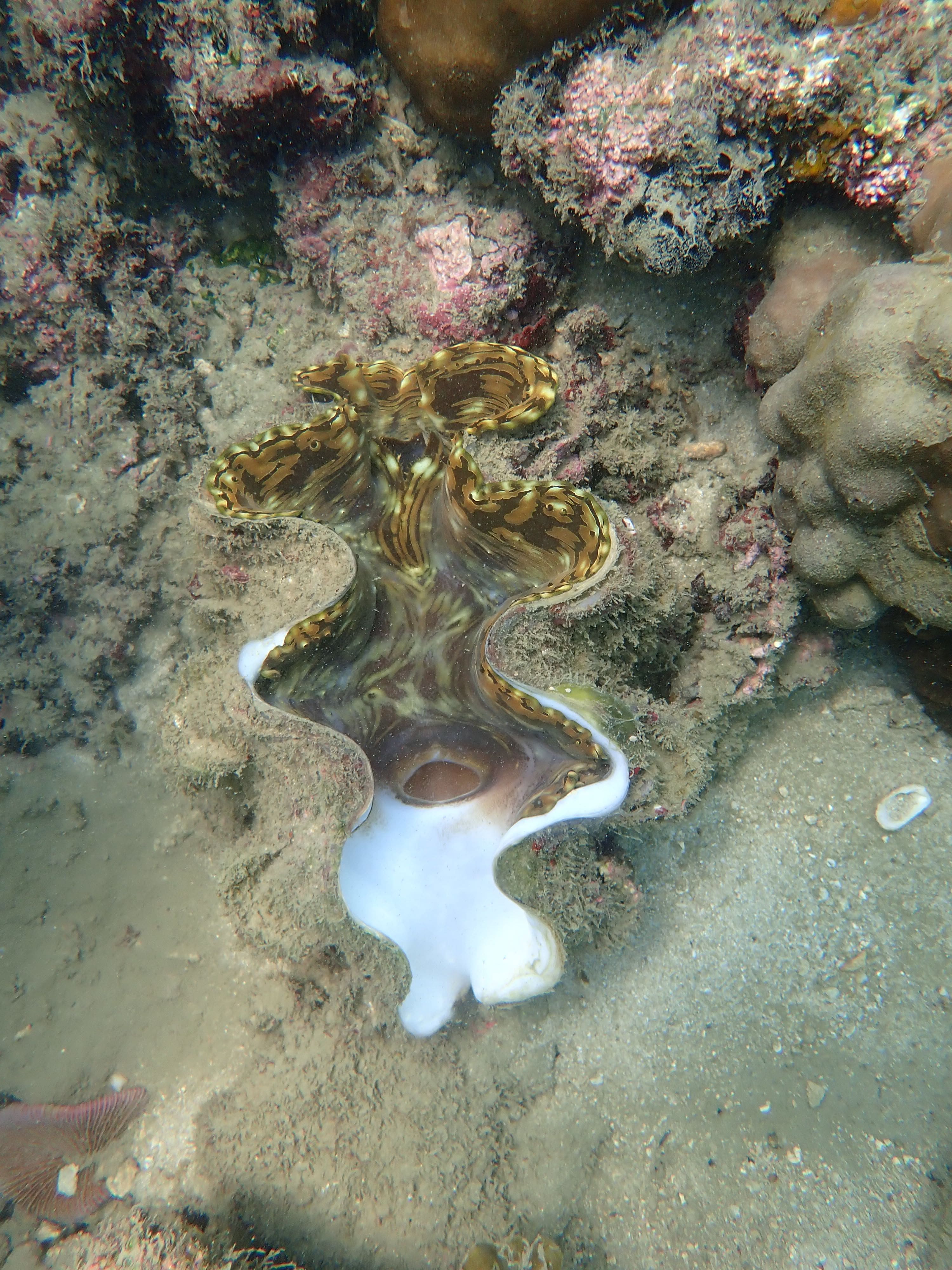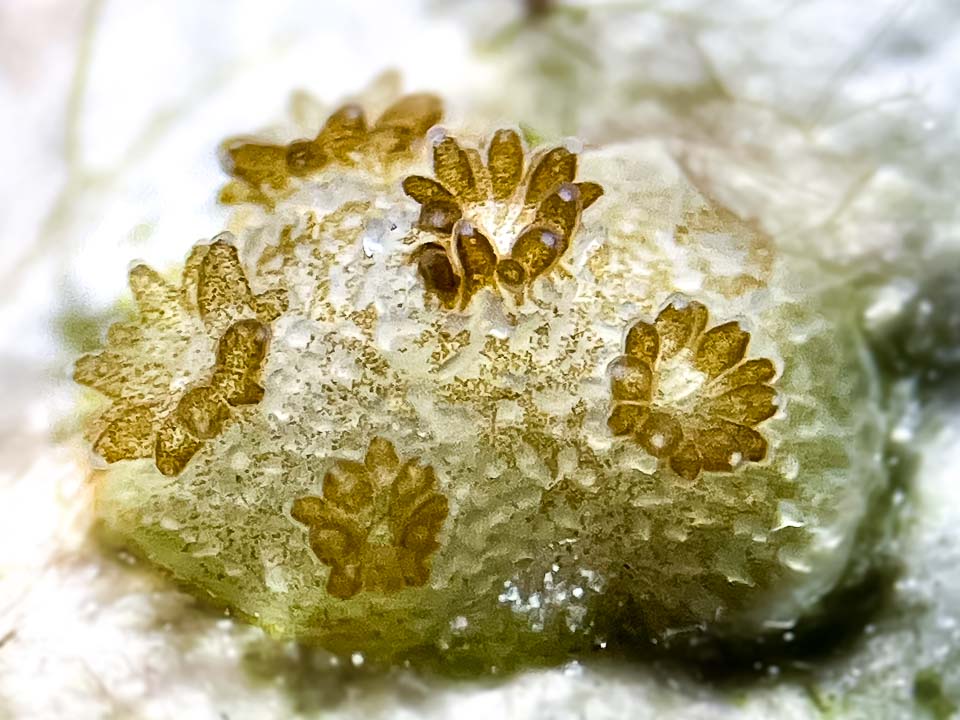Long-term Monitoring Program
The world’s coral reefs are currently undergoing massive changes due to anthropogenic climate climate change, pollution, overfishing, and a plethora of other factors. The effects on a global scale have been severe and saddening, but local systems show different responses.
Our long-term monitoring program has been running since 2011, and the data collected is an essential resource for governments, local management and protection, and scientific research.
Aim
This program aims to measure the long-term status and trends of coral reef ecosystems in Koh Phangan.
What we measure
- Changes in benthic communities – live coral cover surveys
- Coral bleaching
- Juvenile corals
- Reef fish communities
- Coral predators – Drupella, Crown of Thorns starfish
- Giant clams
- Sponge communities
How we measure
Data is collected by trained observers (students/interns/staff) using SCUBA to survey 7 different reefs on a monthly basis around Koh Phangan. Surveys are conducted using standard methodology based off the Australian Institute of Marine Science & Global Coral Reef Monitoring Network.
Juvenile Scleractinian corals – linking bleaching to abundance & diversity declines
Coral recovery following bleaching depends on successful replenishment of juvenile corals, which is influenced by both reproductive processes (larval supply from adult colonies) and post-settlement processes (availability of suitable substrate). Mass bleaching can disrupt these pathways through (1) reproductive limitation, by reducing adult cover and gamete output, and (2) settlement limitation, by altering substrate composition through coral mortality and algal overgrowth. Understanding how these mechanisms jointly constrain juvenile abundance is critical for predicting reef recovery potential in the Gulf of Thailand. This project will be a continuation of a manuscript that is currently being written on juveniles between 2024 and 2025, and will look at how the 2025 bleaching event has affected juveniles in 2026.
Manuscript in preparation.
Research Questions
- How have juvenile coral abundance and diversity changed across the three years (2024-2026) in response to consecutive bleaching events?
- Does bleaching severity in 2025, and the cumulative bleaching exposure from 2024 continue to drive juvenile coral abundance in 2026?
- Does adult coral cover by genus continue to predict juvenile abundance after the 2025 bleaching event, indicating sustained reproductive limitation? (reproductive limitation)
- How has benthic substrate composition (e.g., CCA, turf algae) changed after the 2025 bleaching event, and how does this affect juvenile abundance? (settlement limitation)
- Are juvenile coral declines best explained by the combined effects of reduced adult coral cover and altered substrate composition, rather than either mechanism alone?
Photosynthetic costs of gastropod parasitism in Turbinaria corals
This project builds on ongoing work by Mehrotra et al. (2024) who found gastropod parasites (Epitoniidae spp.) impacting Turbinaria corals around Koh Tao. Here in the Gulf of Thailand, these snails produce mucous threads, especially during egg-laying that trap sediment and organic matter, which may place additional stress on corals in turbid environments. As a result, the same level of parasitism may have far greater physiological impacts in high-turbidity sites than in clearer waters due to increased shading, sediment accumulation, and reduced gas exchange on affected tissue. This project will investigate how turbidity modifies the effects of gastropod parasitism on the photosynthetic performance of Turbinaria colonies and will also document which Turbinaria species host Epitoniidae spp. locally, helping us determine whether parasitism shows species-specific patterns across Koh Phangan’s reefs.
This project is part of our Marine Research internship program.
Research Questions
- Which Turbinaria species host Epitoniidae , and does host identity influence the frequency or severity of parasitism?
- Do parasitised colonies have lower photosynthetic performance than unparasitized colonies?
- Does the physiological impact of gastropod parasitism on Turbinaria colonies differ between turbid and non-turbid reef sites?
- Within parasitised Turbinaria colonies, how does photosynthetic efficiency (YII) vary among (i) parasitised patches, (ii) adjacent tissue (2–5 cm from patch), and (iii) distant healthy tissue (>5 cm from patch)?
%
PROJECT PROGRESS

%
PROJECT PROGRESS
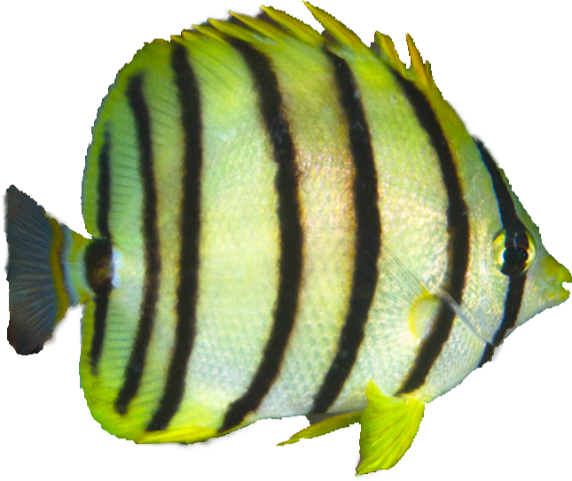
Bleaching-driven shifts in feeding preferences of Chaetodon octofasciatus across consecutive bleaching years (2023–2025)
This project builds upon a dataset between 2023-2025, which characterized the feeding preferences of the eight-banded butterflyfish (Chaetodon octofasciatus) on Koh Phangan’s coral reefs. The study so far has revealed broad dietary flexibility, with individuals consuming over half of the available coral genera but showing strongest associations with specific genera such as Acropora. Between 2023 and 2025, repeated bleaching events substantially altered coral community composition on these reefs, offering a unique opportunity to test how thermal stress and coral mortality influence the feeding ecology of an obligate corallivore.
This project is part of our Marine Research internship program.
Research Questions
- How have octofasciatus feeding preferences and prey selectivity changed following consecutive bleaching events (2023–2025)?
- Does the frequency of bites on preferred coral genera (e.g., Acropora, Pocillopora, Porites) decrease in proportion to bleaching-induced coral loss?
- Do individuals exhibit dietary specialization or broadening under reduced coral availability?
- How does bleaching severity alter prey diversity and selectivity?
- Can feeding flexibility buffer octofasciatus populations against repeated bleaching impacts on coral prey?
Investigating photosynthetic efficiency & performance of major reef-building corals across different turbid environments in the Gulf of Thailand
This project is a continuation of a 2025 project investigating the photosynthetic efficiency and performance of major reef-building corals (Porites, Acropora, Montipora) across turbid reef sites in the Gulf of Thailand. The original work examined how environmental factors (temperature, light, pH, dissolved oxygen) influenced photosynthetic efficiency (YII) and performance (ETR) across sites differing in turbidity and coral community structure. Following the bleaching event in 2025, this continuation aims to assess how photosynthetic activity has changed seasonally and between years (2025–2026), providing insight into coral acclimatization, recovery, or cumulative stress under repeated bleaching events.
Research Questions
- How have photosynthetic efficiency (YII) and performance (ETR) of corals changed between the three turbid reef sites from bleaching (2025) and post-bleaching (2026) periods?
- How do site-specific environmental conditions (light, temperature, pH, dissolved oxygen) explain temporal differences in coral photosynthetic efficiency across years?
- Are certain reef sites showing greater physiological stability or recovery following consecutive bleaching events, indicating potential refugia effects?
- How do seasonal changes in environmental conditions interact with site characteristics to influence coral photosynthetic activity through time?
%
PROJECT PROGRESS
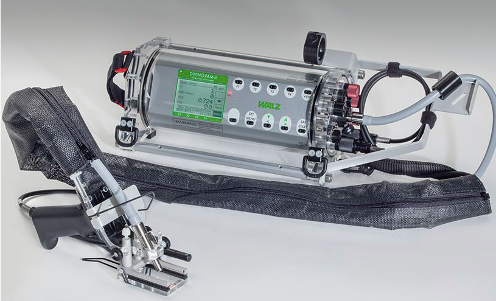
%
PROJECT PROGRESS

Comparative recruitment and photophysiological resilience of reef-building corals on Tridacna shells and surrounding reef substrates, Koh Phangan, Gulf of Thailand
This study aims to assess the ecological role of Tridacna spp. (giant clam) shells as alternative microhabitats supporting coral recruitment, growth, and physiological performance on Koh Phangan’s coral reefs. Based on work done in Koh Tao by Mehrotra et al. (2022) who examined how giant clam shells function as alternative coral recruitment substrates, they found that coral assemblages on clam shells differed markedly from those on surrounding reefs. Building on earlier work, we will compare coral assemblages on living and dead clam shells with those on surrounding reef substrates, while also evaluating how shell morphology and clam photophysiology influence coral settlement, juvenile-to-adult transitions, and photosynthetic efficiency under varying environmental conditions.
This project is part of our Marine Research internship program.
Research Questions
- How does coral recruitment density and diversity on giant clam shells compare to surrounding reef substrates across multiple sites?
- Do living vs. dead clam shells support different coral community compositions?
- Do clam shells primarily act as nursery habitats for early recruits or can they sustain coral growth into adult stages?
- How does shell morphology (scute complexity/rugosity) influence coral settlement?
- Does photophysiological performance of shell hosted coral colonies differ from those on the surrounding reef?
- Do shell hosted coral colonies exhibit greater photophysiological resilience and survival during thermal bleaching events compared to nearby reef corals?
%
PROJECT PROGRESS

Long-term responses of the obligate corallivore Chaetodon octofasciatus to repeated coral bleaching events (2024–2025) in the Gulf of Thailand
This project continues from a 2024 study on the eight-banded butterflyfish (Chaetodon octofasciatus), now under review for publication, which documented delayed declines in adult abundance and sharp reductions in biomass following the 2024 global bleaching event. Juveniles were rare and absent from fully bleached colonies, highlighting how a single event disrupted population structure and coral–fish interactions. A subsequent bleaching event in 2025 provides an opportunity to assess how repeated thermal stress influences long-term demographic trends and habitat dependence in this obligate corallivore on Koh Phangan’s reefs.
This project is part of our Marine Research internship program.
Research Questions
- How have octofasciatus abundance, biomass, and life-stage structure changed across 2024–2026 under consecutive bleaching events?
- How do bleaching severity and live coral cover explain temporal changes in adult and juvenile populations?
- Has juvenile settlement probability and host preference shifted with cumulative bleaching exposure?
- Do the results indicate recovery, persistence, or progressive decline under recurring stress?
From chorus to colonies: investigating coral reef soundscapes on Koh Phangan reefs
There is growing evidence that coral reef soundscapes driven by fish choruses, snapping shrimp, and invertebrate activity are increasingly recognised as indicators of reef health, biodiversity and habitat quality. Healthy reefs tend to produce more complex and energetic acoustic signatures, and recent studies show that coral larvae can actually detect and orient toward “healthy-sounding” reefs. By monitoring soundscapes year-round on Koh Phangan’s reefs, we can establish natural seasonal baselines while assessing how biophony changes around key ecological events such as coral spawning and bleaching events. Because biophonic activity often declines under environmental stress, acoustic data may provide an early, low-impact signal of degradation and offer insight into how altered soundscapes influence larval settlement potential. This pilot project therefore aims to characterise temporal patterns in reef soundscapes and evaluate their usefulness as indicators of reef condition and recruitment processes.
Research Questions
- Do coral reef soundscapes change seasonally?
- Do soundscapes differ pre-, during, and post coral spawning season?
- Do soundscapes weaken during/after coral bleaching events?
%
PROJECT PROGRESS
%
PROJECT PROGRESS
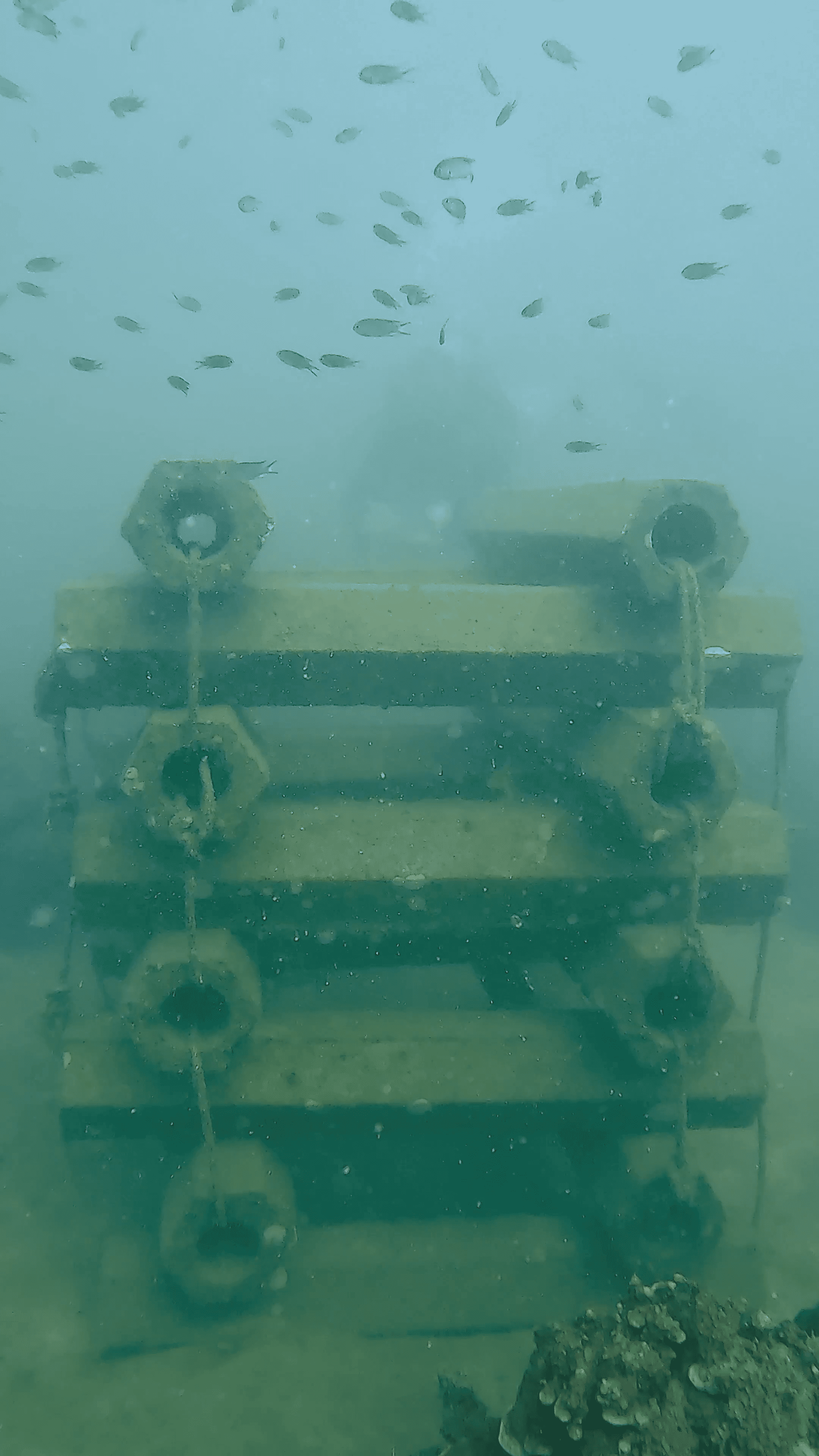
Artificial vs. Natural reefs – Fish diversity & behaviour
Artificial reef structures are increasingly used across the Indo-Pacific to enhance habitat complexity, promote coral restoration, and attract reef-associated fish. However, the ecological role these structures play relative to adjacent natural reefs remains poorly understood, particularly regarding how they influence fish assemblage composition and behaviour. Structural complexity, relief, and living coral cover are known to mediate habitat use, yet it is unclear whether artificial substrates such as modular concrete hex-pipes support comparable levels of diversity, foraging, and sheltering activity. Understanding these dynamics is crucial to evaluate whether such installations function merely as aggregation sites or contribute to genuine habitat production and ecological recovery. This project will therefore compare fish diversity, abundance, and behavioural patterns between artificial hex-stack reefs and nearby natural reef patches around Koh Phangan to assess their relative ecological value and functionality.
This project is part of our Marine Research internship program.
Research Questions
- Do fish assemblage composition and diversity differ between artificial reef structures and natural reef habitats?
- How do rates of key behaviours (e.g. feeding, sheltering, schooling, and territorial interactions) vary across these habitat types?
- Does structural complexity and live coral cover explain observed differences in fish abundance or behaviour?
- Are artificial structures serving primarily as aggregation sites or as productive habitats supporting distinct fish communities over time?
Giant Clam Proximity Effects on Coral Bleaching and Photosynthetic Performance
Giant clams (Tridacna spp.) form symbiotic relationships with zooxanthellae similar to those in reef-building corals. There is increasing evidence that clams may act as local “photosynthetic hotspots” and potentially influence the bleaching resistance of nearby corals through shared micro-environments, nutrient exchange, or even symbiont transfer. Understanding how clams affect surrounding coral physiology could reveal novel resilience mechanisms within coral reef communities during heat stress events.
Research Questions
- Does coral bleaching severity differ with proximity to giant clams?
- Are the photosynthetic efficiencies (YII) of clams and adjacent corals correlated during thermal stress?
- Do corals in close proximity to clams show evidence of similar symbiont (zooxanthellae) characteristics, suggesting potential recycling or sharing?
%
PROJECT PROGRESS
